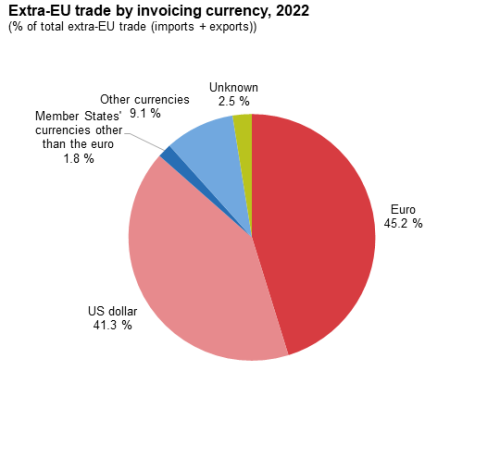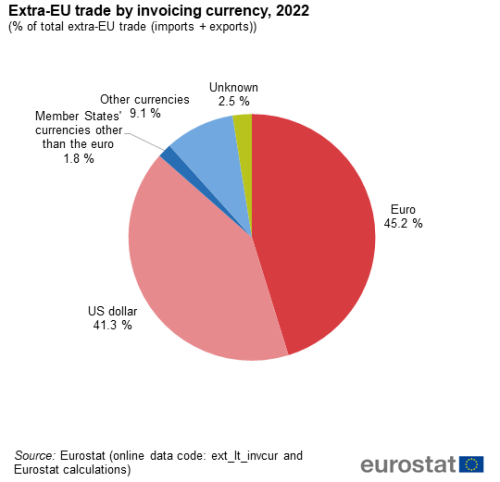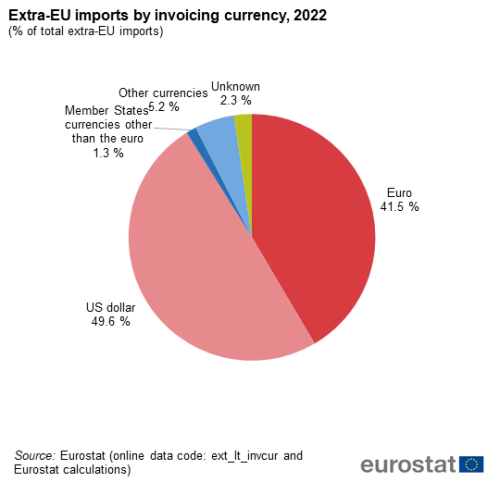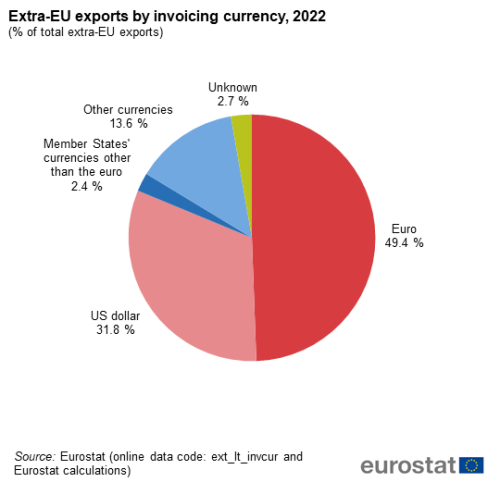
US dollar most used for EU imports, euro most used for EU exports in 2022
Figure 1 shows that in total extra-EU trade in goods (imports plus exports), the euro was the most used currency in 2020, with a share of 45 %. The US dollar followed with a share of 41 %. Member States’ currencies other than the euro had a share of 2 %, the share of other currencies was 3 % while the currency was unknown for 8 % of trade. However, the shares are rather different when looking at imports and exports separately.

Source: Eurostat (ext_lt_invcur)
Figure 2 shows that the US dollar was the most used currency for imports into the EU in 2022, with a share of 50 %. The euro was the second most used currency with a share of 42 %. The share of Member States’ currencies other than the euro was 1 %. Other currencies had a share of 5 % while for 2 % of imports the currency was unknown.

Source: Eurostat (ext_lt_invcur)
Compared with imports, the positions of the euro and the US dollar are reversed for EU exports (see Figure 3). The share for the euro in 2022 was 49 %, ahead of the US dollar with 32 %. Member States’ currencies other than the euro had a share of 2 % and other currencies had a share of 14 %. For 3 % of exports the currency was unknown.

Source: Eurostat (ext_lt_invcur)
In 19 of the 27 Member States the US dollar was the most used currency for extra-EU imports of goods in 2022 (Figure 4). Its share was highest in Finland (67 %) and lowest in Slovenia (22 %). The euro was the most used currency in seven Member States. Slovenia (70 %), Croatia (59 %), Latvia (63 %), Slovakia (60 %), Austria (58 %), Italy (57 %) and Luxembourg (48 %) while Hungary had equal shares for the euro and dollar (both 45 %). Member States’ currencies other than the euro had a share above 10 % only in Czechia (23 %), Croatia and Denmark (both 13 %). Finally, other currencies had a share above 10 % only in Ireland(14 %), Sweden and Denmark (both 12 %).

(% of total extra-EU exports)
Source: Eurostat (ext_lt_invcur)
In 18 of the 27 Member States the euro was the most used currency for extra-EU exports of goods in 2022 (Figure 5). Its share was above 70 % in Slovenia (89 %), Lithuania (78 %), Croatia (76 %) and Latvia (75 %) and lowest in Ireland (15 %). The US dollar was the most used currency in eight Member States. Its share was highest in Cyprus (70 %) and Ireland (66 %). Member States’ currencies other than the euro had a share above 10 % only in Sweden (50 %) and Denmark (14 %). Lastly, other currencies had a share above 10 % in 11 countries. It was above 20 % in Denmark (25 %), Slovakia (23 %) and Malta (21 %).

(% of total extra-EU imports)
Source: Eurostat (ext_lt_invcur)
Oil predominantly traded in US dollars, primary goods more often in euro
Looking at imports based on the Standard International Trade Classification (SITC) sections (see Figure 6), the US dollar stands out as the main currency used for imports of petroleum products (SITC 33) (80 % in 2022). In manufactured goods (SITC 5-8) the US dollar (47 %) was also the main currency ahead of the euro (42 %). In primary goods (SITC 0-4) excluding petroleum, the euro (60 %) had the highest share ahead of the US dollar (35 %).

(% of extra EU imports by product group)
Source: Eurostat (ext_lt_invcur)
In extra-EU exports of petroleum products, the US dollar (64 %) is also the most used currency, although somewhat less dominant than in imports. With 57 % the euro is the most used currency in primary goods ahead of the US dollar with 25 %. In manufactured goods the euro has a share of 50 % and the US dollar had 30 % (see Figure 7).

(% of extra EU exports by product group)
Source: Eurostat (ext_lt_invcur)
Source data for tables and graphs
Data sources
Data on trade by invoicing currency (TIC) is collected by using the customs declarations. Trade operators fulfilling their reporting obligations to the customs authorities in a Member State provide at the same occasion these statistical data elements, including the invoicing currency. The Member States collect, compile and transmit TIC data to Eurostat in line with the legislation in force. The data source shall be the information recorded from customs declarations according to Article 4(1) of Regulation (EC) No 471/2009. However, if the invoicing currency for exports is not available on the customs declaration, Member States shall carry out a survey for compiling exports broken down by invoicing currency which provides statistics with accurate results. The first reference year for which extra-EU trade by invoicing currency is available is 2010. Data are compiled for every second calendar year since then, i.e. 2012, 2014, 2016 etc.
The United Kingdom is considered as an extra-EU partner country for the EU for the whole period covered by this article. However, the United Kingdom was still part of the internal market until the end of the transitory period (31 December 2020), meaning that data on trade with the United Kingdom are still based on statistical concepts applicable to trade between the EU Member States. Consequently, while imports from any other extra-EU trade partner are grouped by country of origin, the United Kingdom data reflect the country of consignment. In practice this means that the goods imported by the EU from the United Kingdom were physically transported from the United Kingdom but part of these goods could have been of other origin than the United Kingdom. For this reason, data on trade with the United Kingdom are not fully comparable with data on trade with other extra-EU trade partners.
Product classification
Information on exported and imported goods are presented according to the Standard international trade classification (SITC) at a more general level.
- SITC 5-8 Manufactured goods
- SITC 33 Petroleum, petroleum products and related materials
- SITC 0-4A Primary goods excluding SITC division 33
- Total All products
A full description is available from Eurostat’s classification server [1].
Determination of currency
For trade relating simultaneously to reference year 2020 and transactions between the Member States and the United Kingdom, the invoicing currency is likely to be unknown as the Intrastat declaration remains the means of collection during the transition period (February-December 2020). For trade related to reference years before 2020 statistics should be accurate enough to avoid the use of the unknown category. Residual trade that cannot be attributed to any code is proportionally distributed to each currency. Only if such a distribution would bias the data in a significant way, trade is attributed to the unknown category. Therefor the unknown category relates mainly to trade transactions with UK.
Context
Currencies are the means by which wealth is stored, protected and exchanged between countries, organisations and individuals. A global currency, such as the euro, does this on a global scale. As well as serving as the currency of the euro area, the euro has a strong international presence. Since its introduction in 1999, it has firmly established itself as a major international currency, second only to the US dollar. The size, stability and strength of the euro-area economy make the euro increasingly attractive beyond its borders, too. Public and private sectors in third countries acquire and use the euro for many purposes, including for trade or as currency reserves.



